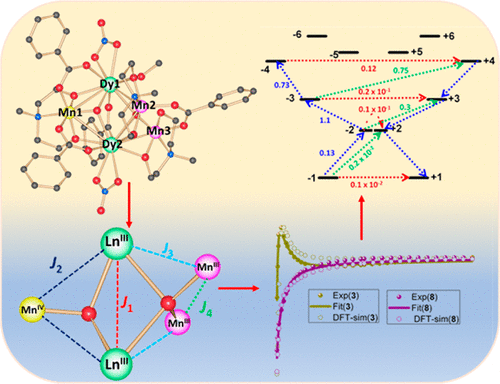当前位置:
X-MOL 学术
›
Inorg. Chem.
›
论文详情
Our official English website, www.x-mol.net, welcomes your
feedback! (Note: you will need to create a separate account there.)
Understanding the Mechanism of Magnetic Relaxation in Pentanuclear {MnIVMnIII2LnIII2} Single-Molecule Magnets
Inorganic Chemistry ( IF 4.3 ) Pub Date : 2018-01-08 00:00:00 , DOI: 10.1021/acs.inorgchem.7b02608 Kuduva R. Vignesh 1 , Stuart K. Langley 2 , Boujemaa Moubaraki 3 , Keith S. Murray 3 , Gopalan Rajaraman 4
Inorganic Chemistry ( IF 4.3 ) Pub Date : 2018-01-08 00:00:00 , DOI: 10.1021/acs.inorgchem.7b02608 Kuduva R. Vignesh 1 , Stuart K. Langley 2 , Boujemaa Moubaraki 3 , Keith S. Murray 3 , Gopalan Rajaraman 4
Affiliation

|
A new family of heterometallic pentanuclear complexes of formulas [MnIVMnIII2LnIII2O2(benz)4(mdea)3(NO3)2(MeOH)] (Ln = Dy (1-Dy), Tb (2-Tb), Gd (3-Gd), Eu (4-Eu), Sm (5-Sm), Nd (6-Nd), Pr (7-Pr); benz(H) = benzoic acid; mdeaH2= N-methyldiethanolamine) and [MnIVMnIII2LnIII2O2(o-tol)4(mdea)3(NO3)2(MeOH)] (Ln = Gd (8-Gd), Eu (9-Eu); o-tol(H) = o-toluic acid) have been isolated and structurally, magnetically, and theoretically characterized. dc magnetic susceptibility measurements reveal dominant antiferromagnetic magnetic interactions for each complex, except for 2-Tb and 3-Gd, which reveal an upturn in the χMT product at low temperatures. The magnetic interactions between the spin centers in the Gd derivatives, 3-Gd and 8-Gd, which display markedly different χMT vs T profiles, were found to be due to the interactions of the GdIII–GdIII ions which change from ferromagnetic (3-Gd) to antiferromagnetic (8-Gd) due to structural differences. ac magnetic susceptibility measurements reveal a nonzero out-of-phase component for 1-Dy and 7-Pr, but no maxima were observed above 2 K (Hdc = 0 Oe), which suggests single-molecule magnet (SMM) behavior. Out-of-phase signals were observed for complexes 2-Tb, 4-Eu, 8-Gd, and 9-Eu, in the presence of a static dc field (Hdc = 2000, 3000 Oe). The anisotropic nature of the lanthanide ions in the benzoate series (1-Dy, 2-Tb, 5-Sm, 6-Nd, and 7-Pr) were thoroughly investigated using ab initio methods. CASSCF calculations predict that the origin of SMM behavior in 1-Dy and 7-Pr and the applied field SMM behavior in 2-Tb does not solely originate from the single-ion anisotropy of the lanthanide ions. To fully understand the relaxation mechanism, we have employed the Lines model to fit the susceptibility data using the POLY_ANISO program, which suggests that the zero-field SMM behavior observed in complexes 1-Dy and 7-Pr is due to weak MnIII/IV–LnIII and LnIII–LnIII couplings and an unfavorable LnIII/MnIII/MnIV anisotropy. In complexes 4-Eu, 8-Gd, and 9-Eu ab initio calculations indicate that the anisotropy of the MnIII ions solely gives rise to the possibility of SMM behavior. Complex 7-Pr is a Pr(III)-containing complex that displays zero-field SMM behavior, which is rare, and our study suggests the possibility of coupling weak SOC lanthanide metal ions to anisotropic transition-metal ions to derive SMM characteristics; however, enhancing the exchange coupling in {3d–4f} complexes is still a stubborn hurdle in harnessing new generation {3d–4f} SMMs.
中文翻译:

了解五核{Mn IV Mn III 2 Ln III 2 }单分子磁体中磁弛豫的机理
分子式为[Mn IV Mn III 2 Ln III 2 O 2(苯)4(mdea)3(NO 3)2(MeOH)的杂金属五核配合物的新家族](Ln = Dy(1-Dy),Tb(2 -Tb),Gd(3-Gd),Eu(4-Eu),Sm(5-Sm),Nd(6-Nd),Pr(7-Pr);苯(H)=苯甲酸; mdeaH 2 = N-甲基二乙醇胺)和[Mn IV Mn III 2 Ln III 2 O2(邻甲苯)4(mdea)3(NO 3)2(MeOH)](Ln = Gd(8-Gd),Eu(9-Eu);邻甲苯(H)=邻甲苯甲酸)被隔离并在结构,磁性和理论上进行了表征。直流磁化率测量表明主导反铁磁磁相互作用为每个复杂,除了2-Tb的和3的Gd,这揭示在χ好转中号Ť在低温下的产物。Gd衍生物3-Gd和8-Gd中自旋中心之间的磁相互作用,其显示显着不同的χ中号Ť VS Ť型材,被认为是由于钆的相互作用III -Gd III离子,其变化从铁磁(3-钆)到反铁磁(8钆)由于结构上的差异。交流磁化率测量显示1-Dy和7-Pr的非零异相分量,但在2 K(H dc = 0 Oe)以上未观察到最大值,这表明单分子磁体(SMM)行为。对于复合物2-Tb,4-Eu,8-Gd和9-Eu观察到异相信号,存在一个静态直流场(H dc = 2000,3000 Oe)。使用从头算方法彻底研究了苯甲酸酯系列(1-Dy,2-Tb,5-Sm,6-Nd和7-Pr)中镧系离子的各向异性。CASSCF计算预测出1-Dy和7-Pr中SMM行为的起源以及2-Tb中所应用的场SMM行为并不完全源自镧系离子的单离子各向异性。为了充分理解弛豫机理,我们使用Lines模型使用POLY_ANISO程序拟合磁化率数据,这表明在配合物1-Dy和7-Pr中观察到的零场SMM行为是由于弱的Mn III / IV引起的。 -Ln III和Ln III -Ln III偶联以及不利的Ln III / Mn III / Mn IV各向异性。在配合物4-Eu,8-Gd和9-Eu中,从头算计算表明Mn III的各向异性离子仅引起SMM行为的可能性。配合物7-Pr是一种含Pr(III)的配合物,显示零场SMM行为,这种情况很少见,我们的研究表明,将弱SOC镧系元素金属离子与各向异性过渡金属离子偶合以产生SMM特性的可能性。但是,增强{3d–4f}复合物中的交换耦合仍然是利用新一代{3d–4f} SMM的顽固障碍。
更新日期:2018-01-08
中文翻译:

了解五核{Mn IV Mn III 2 Ln III 2 }单分子磁体中磁弛豫的机理
分子式为[Mn IV Mn III 2 Ln III 2 O 2(苯)4(mdea)3(NO 3)2(MeOH)的杂金属五核配合物的新家族](Ln = Dy(1-Dy),Tb(2 -Tb),Gd(3-Gd),Eu(4-Eu),Sm(5-Sm),Nd(6-Nd),Pr(7-Pr);苯(H)=苯甲酸; mdeaH 2 = N-甲基二乙醇胺)和[Mn IV Mn III 2 Ln III 2 O2(邻甲苯)4(mdea)3(NO 3)2(MeOH)](Ln = Gd(8-Gd),Eu(9-Eu);邻甲苯(H)=邻甲苯甲酸)被隔离并在结构,磁性和理论上进行了表征。直流磁化率测量表明主导反铁磁磁相互作用为每个复杂,除了2-Tb的和3的Gd,这揭示在χ好转中号Ť在低温下的产物。Gd衍生物3-Gd和8-Gd中自旋中心之间的磁相互作用,其显示显着不同的χ中号Ť VS Ť型材,被认为是由于钆的相互作用III -Gd III离子,其变化从铁磁(3-钆)到反铁磁(8钆)由于结构上的差异。交流磁化率测量显示1-Dy和7-Pr的非零异相分量,但在2 K(H dc = 0 Oe)以上未观察到最大值,这表明单分子磁体(SMM)行为。对于复合物2-Tb,4-Eu,8-Gd和9-Eu观察到异相信号,存在一个静态直流场(H dc = 2000,3000 Oe)。使用从头算方法彻底研究了苯甲酸酯系列(1-Dy,2-Tb,5-Sm,6-Nd和7-Pr)中镧系离子的各向异性。CASSCF计算预测出1-Dy和7-Pr中SMM行为的起源以及2-Tb中所应用的场SMM行为并不完全源自镧系离子的单离子各向异性。为了充分理解弛豫机理,我们使用Lines模型使用POLY_ANISO程序拟合磁化率数据,这表明在配合物1-Dy和7-Pr中观察到的零场SMM行为是由于弱的Mn III / IV引起的。 -Ln III和Ln III -Ln III偶联以及不利的Ln III / Mn III / Mn IV各向异性。在配合物4-Eu,8-Gd和9-Eu中,从头算计算表明Mn III的各向异性离子仅引起SMM行为的可能性。配合物7-Pr是一种含Pr(III)的配合物,显示零场SMM行为,这种情况很少见,我们的研究表明,将弱SOC镧系元素金属离子与各向异性过渡金属离子偶合以产生SMM特性的可能性。但是,增强{3d–4f}复合物中的交换耦合仍然是利用新一代{3d–4f} SMM的顽固障碍。









































 京公网安备 11010802027423号
京公网安备 11010802027423号